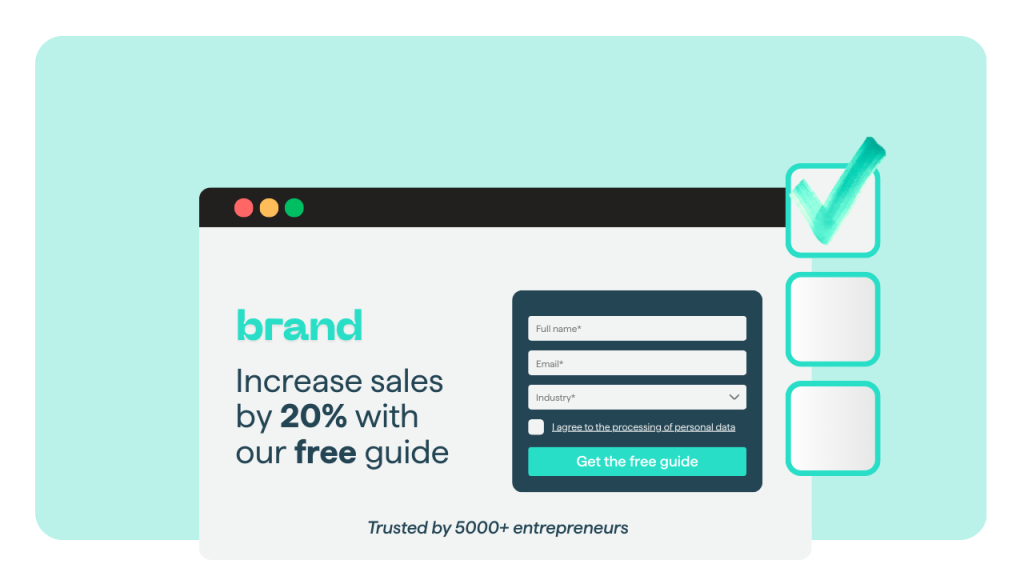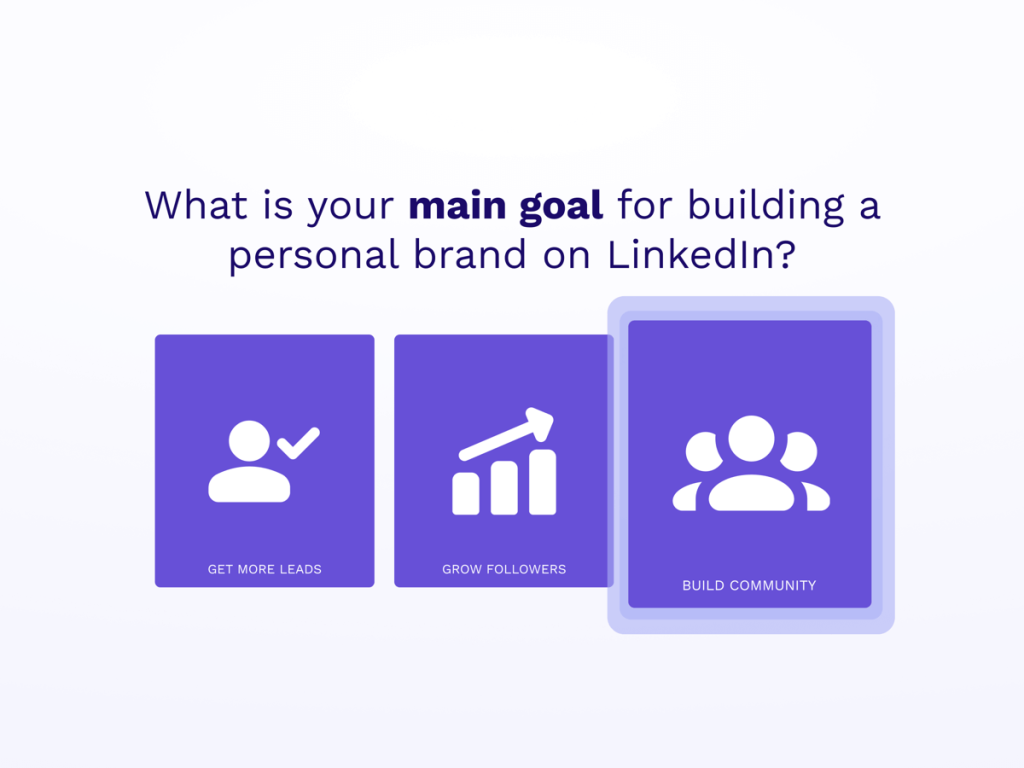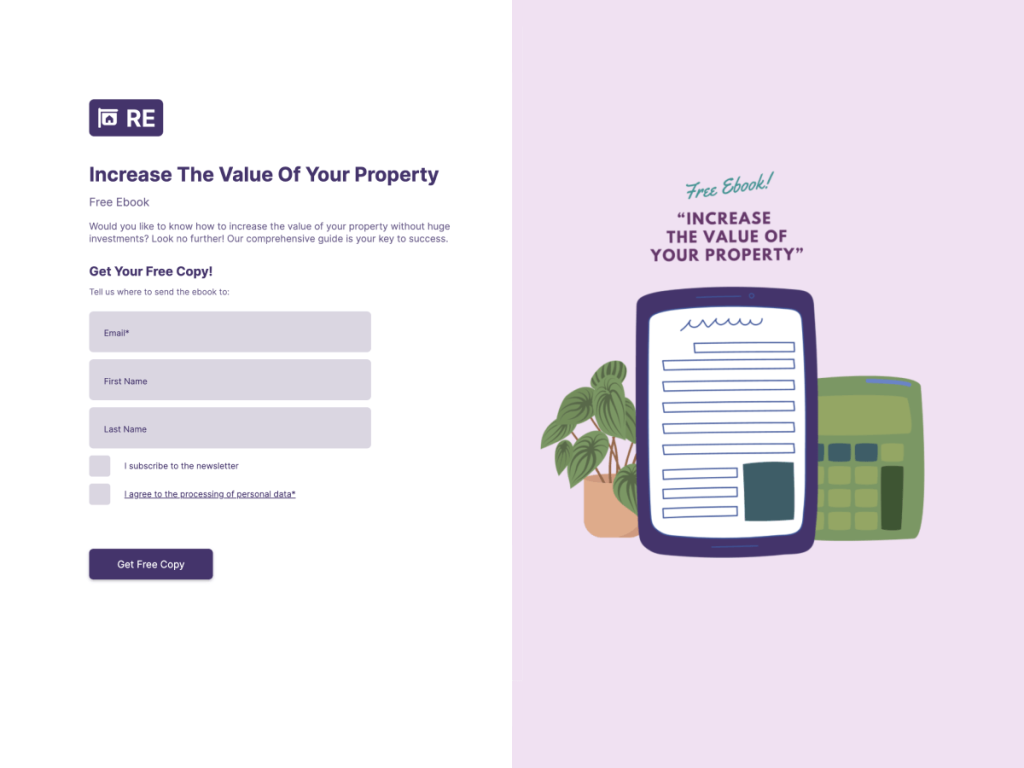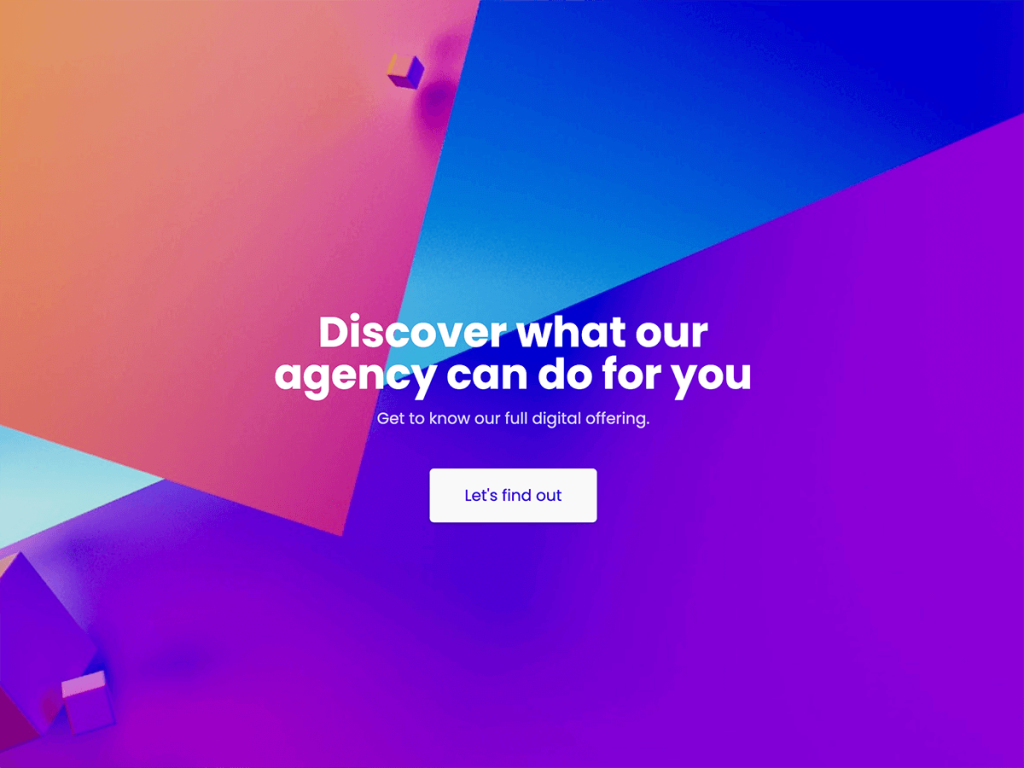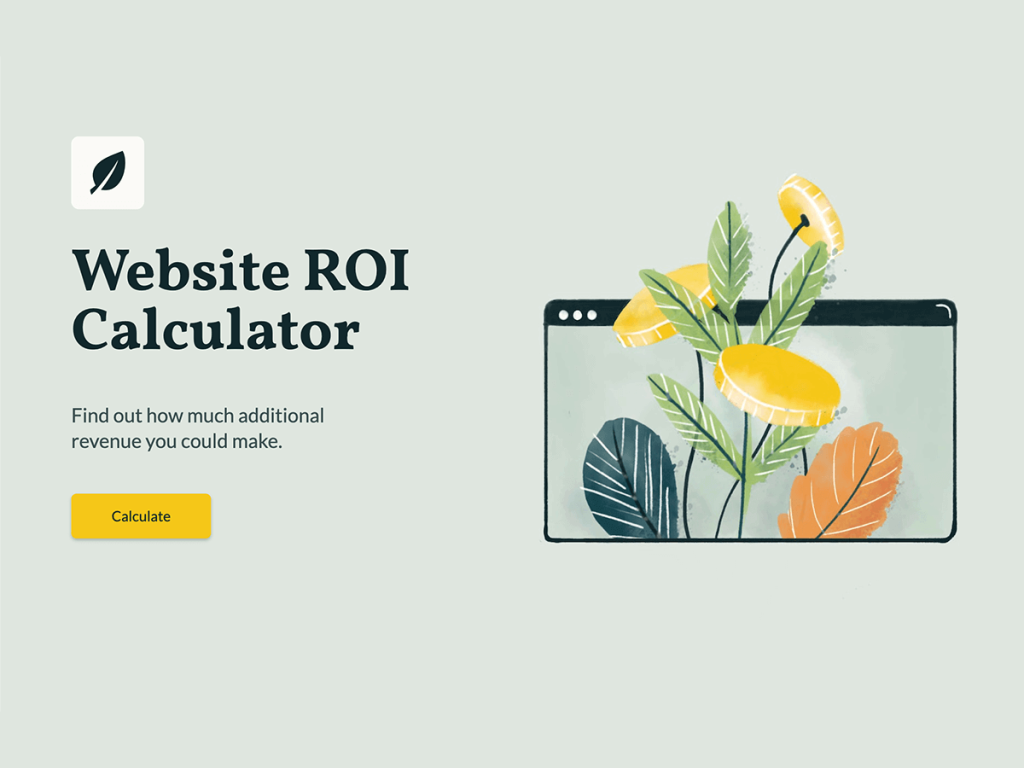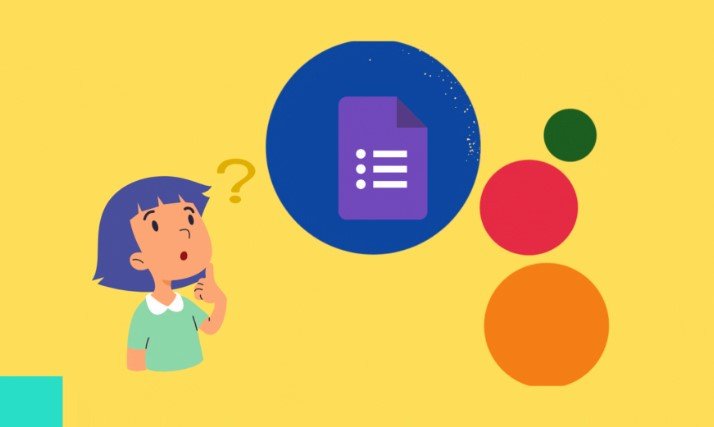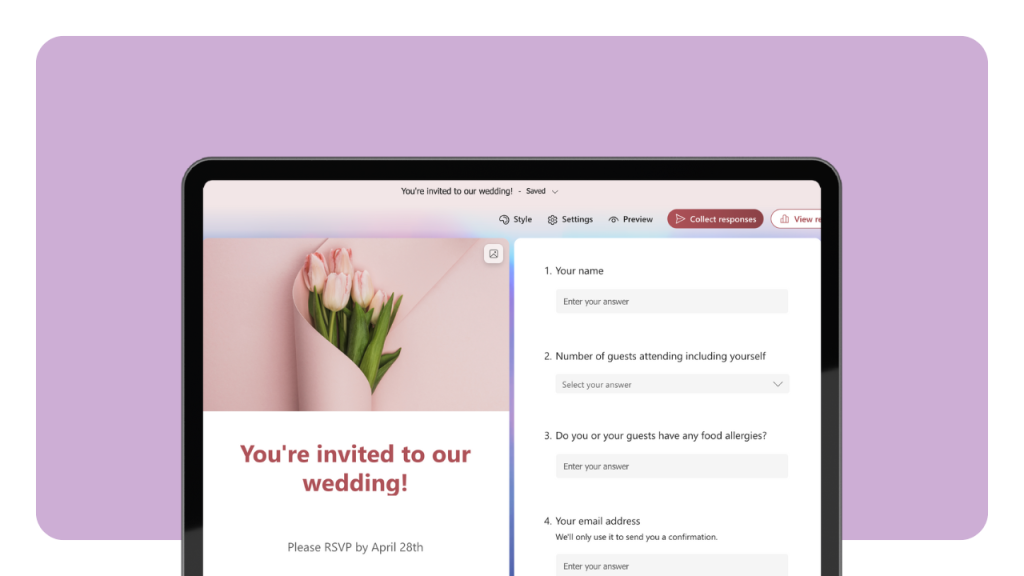A landing page is the finish line, not a maze. Unlike a regular webpage with menus and rabbit holes, a landing page has one job: convert. Tools like involve.me make it fast to build a clean page in hours, not weeks.
But the tool is only half the story. The tactics to optimize your landing page are what move the needle.
Here are 11 landing page best practices for high-converting pages, all covered in this article:
Match the message on your landing page with your ad
Optimize the above-the-fold section
Use directional cues to guide visitors toward your CTA
Increase engagement with the right visuals
Remove navigation and other distractions
Use social proof to build trust and credibility
Use clear and compelling copy
Make sure your landing page loads fast
Optimize for mobile devices
A/B test your landing page ongoingly
Use a template over a blank landing page
Create a landing page that follows best practices
1) Why Should Your Landing Page Match Your Ad?
One word: consistency.
Your landing page should mirror the promise in the ad that brought the click. Same headline. Same offer. Same tone. That instant “yep, I’m in the right place” feeling lowers bounce rate, provides a seamless user experience, and increases conversions.
Clear message match = higher trust and lower bounce rate.
If the ad says “50% off running shoes” and the page shows a generic catalog, people feel confused and leave. Keep the promise thread tight. In the same way, if your ad says “Free Budget Planner Template.” Your landing page headline should read “Free Budget Planner Template.” Not “Financial Tips.” Simple.
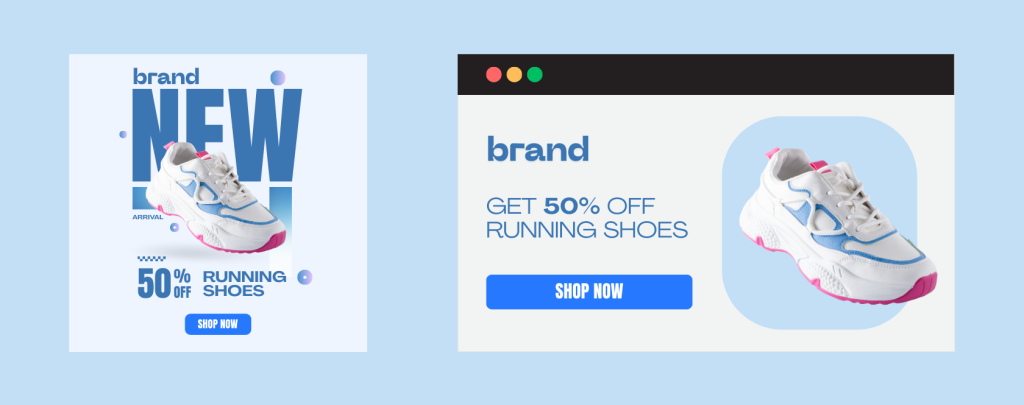
Personalization helps too. Many teams use dynamic text so an ad target keyword like “running shoes” auto-appears in the headline. Relevance and Quality Score (for Google Ads) go up, costs often go down.
Involve.me tip: involve.me makes message match easy. You can duplicate and tailor great landing page templates for each ad group, and even use variables for personalized copy insertion. For instance, pass a query parameter from your ad’s URL into your involve.me page to automatically populate the headline with the user’s search term. This way, every visitor sees an engaging landing page that speaks exactly to what they clicked, which builds trust from the first second.
2) What’s the Most Important Thing to Put Above the Fold?
Your above-the-fold content (what’s visible on screen before scrolling) is prime real estate, it creates the critical first impression.
The most important visual elements are the headline and primary call to action (CTA).
In one glance, people should know what you’re offering, why it matters, and where to click next.
Aim for:
Clear value prop headline. A bold statement or question that highlights your USP (unique selling point) or biggest benefit. Keep it customer-first. Example: “Increase your email signups by 50% in 7 days.”
Bold CTA button. High-contrast color, action-oriented text. “Get my free ebook.” “Start free trial.”. This should be impossible to miss.
Short subhead or 3 crisp benefits. One or two lines expanding on the headline, or a bullet list of 3 quick benefits. Keep it concise and relevant to the visitor’s pain point or goal.
Optional visual or short form. A clean product image or 30–90 second video can reinforce the message. If your desired action is lead capture for a simple offer (like an eBook or newsletter signup), a small form right in the hero lets motivated landing page visitors convert immediately. Otherwise, use a strong call to action button to lead into the form further down.
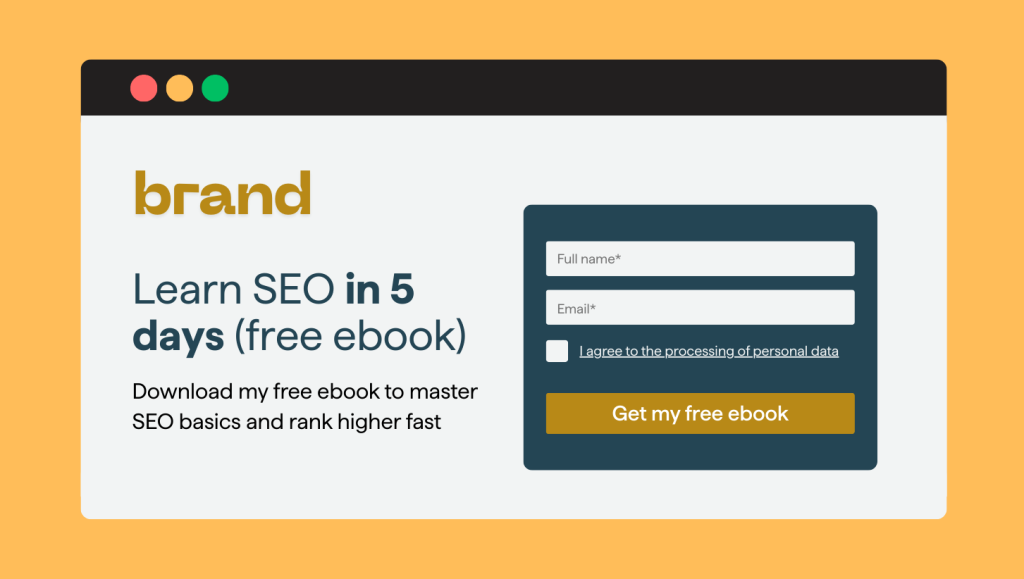
Keep it light. Less is more above the fold. Most people spend a huge chunk of time above the fold, so put your best stuff there, but not everything. Tease the story. Earn the scroll.
Additional info, like features or testimonials, can come after the fold once you’ve hooked them.
Involve.me tip: Using involve.me’s drag-and-drop builder, you can arrange your above-the-fold elements in seconds. Then drop in a form or video. Use the mobile preview to confirm your headline and CTA don’t get pushed below the first screen on phones.
3) How Do Directional Cues Help Conversion?
People’s eyes follow signals. Use directional cues to guide visitors' attention toward your call to action button or form.
There are two types of directional cues:
Explicit cues: arrows, pointers, graphics (eg. a person literally pointing at your form). Clear and hard to miss. A face looking toward your CTA works too. In eye-tracking tests, when a model looked at the copy, readers did as well.
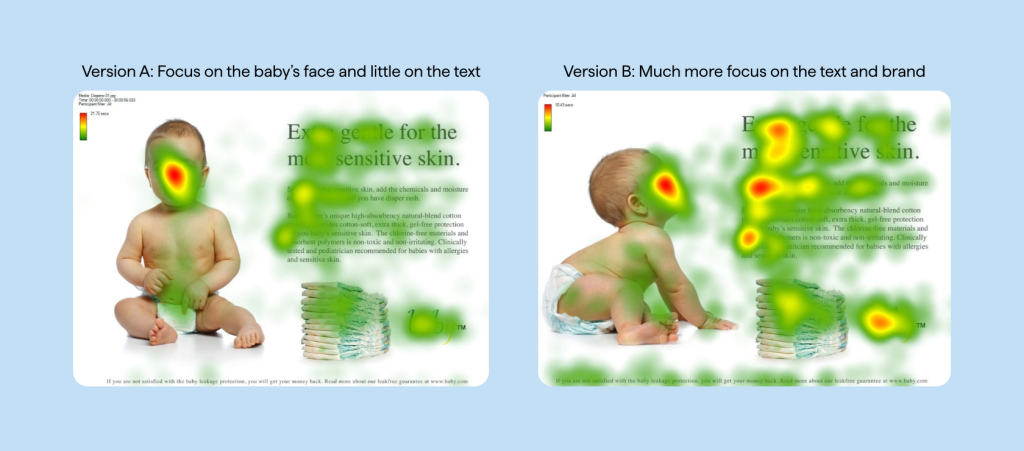
Image source: Objective Experience
Implicit cues: subtle design elements such as white space, contrasting CTA button, and clean layout that funnel the eye. For example, if your page background is white and most of your landing page colors are soft, a big orange or blue button will pop out. Also, a form isolated with plenty of blank space around it stands out as the focal point.
Here are a few quick wins:
Make your call to action look like a button. Obvious shape, bold color, big enough.
Use contrast and spacing to spotlight important elements.
Don’t spam arrows. One or two strong cues beat a dozen weak ones.
Involve.me tip: You don’t need a graphic designer to add directional cues – involve.me’s builder includes landing page design elements like arrows, pointers, and shapes that grab visitors' attention, you can drag onto your page. You can also easily adjust button colors for high contrast
4) How Do Visuals Increase Engagement?
The right visuals do heavy lifting. They grab attention, explain faster than text, and make your offer feel real.
Use them smartly:
Show your product in context. Real screenshots, real photos, real use cases. Make it tangible. This helps landing page visitors visualize themselves benefiting from your offer. For example, a good landing page for a meal-kit delivery might show a family cooking with the ingredients, rather than just a logo or a random smiling person.
Pick human images that feel authentic. Real customers and team members beat cheesy stock, they build trust and empathy. But avoid stock photos. As explained above, if you show a person, try to align their gaze toward your CTA or copy.
Avoid generic stock. Users can sniff out cheesy stock images, and their trust drops. If you must use stock, choose natural, on-brand high quality images or illustrations that actually support the message. Avoid those overly staged corporate handshake pictures unrelated to your message. Authenticity is key.
Consider video. A short explainer or demo can lift time on page and conversion rates by up to 86%, as long as it has a clear purpose. Why? Video can quickly illustrate the benefits and build an emotional connection. But make sure to keep it tight (30sec to 2min), add captions, and pair it with a clear CTA.
Caption key visuals. Don’t assume the landing page image alone is self-explanatory and will do all the work. A one-liner next to a screenshot can drive the point home. And if you show a customer using the product, label it with their testimonial or a benefit callout.
Optimize file sizes. Fast pages win. Always. Engaging visuals shouldn’t come at the cost of speed. Optimize images and use modern formats so your page still loads fast. (More on page speed later).
Bottom line: visuals should carry your story forward, not decorate it.
Involve.me tip: Involve.me makes it easy to embed videos (YouTube, Vimeo, Wistia, Spotlight, or HTML5) directly into your landing pages, no coding required. You can simply drag a Video element. The builder also has image widgets, you can upload screenshots, product photos, or even use built-in Unsplash/GIPHY integrations for high-quality visuals.
5) Why Remove Navigation and Other Distractions?
When it comes to landing pages, one page = one job. Menus and extra links leak attention. You don’t want to encourage visitors to click on your About Us link. Remove them and you reduce exits, confusion, and decision fatigue. Conversion goes up, especially for MOFU (middle of the funnel) pages, where the conversion rate can increase by 16 to 28% without top navigation.
Do this:
No top nav. Use a simplified header. Logo is fine, but skip the multi-link menu.
Minimal footer. Avoid the full site footer with dozens of unnecessary links. Have a trimmed version with legal links if needed (for compliance), maybe a secondary CTA or trust badges.
No sidebar clutter. Remove sidebars, social media feeds, “related blog posts,” or any widgets that are not part of the conversion goal.
Focus on one primary CTA. That doesn’t mean you only have a single call to action button on the entire page, you can repeat the same CTA, but avoid competing choices (eg. “Sign up” and “Learn more” and “Download brochure”).
A study from Hubspot highlighted that only 16% of landing pages were found to be free of navigation, meaning if you adopt this great landing page best practice, you’re doing what 84% of marketers might be neglecting.

Involve.me tip: The good news is involve.me’s landing pages have no navigation and footer by default when you publish as standalone pages. You can brand with a logo, keep the focus, and run the experience distraction-free. Involve.me also provides built-in focus features like progress bars or timed sections, but all are geared towards keeping the user moving forward on the page. Essentially, the platform encourages landing page best practices by design
6) How Can Social Proof Increase Your Landing Page Conversions?
Social proof is the psychological concept that people look to others’ experiences to determine their own choices. In landing page terms, it means showing evidence that “people like you have benefited from this, so you can trust it.”. It answers questions like “This sounds good but can I trust it? Does it actually work for others?”.
Social proof builds trust, credibility, and removes risk.
Here are some powerful proof elements to consider adding:
Customer testimonials. Quotes from happy customers, ideally with a name, photo, and concrete result. For example: “We grew signups 300% in 3 months. - Jane D, Marketing Manager”. Keep testimonials short and place them near your CTA or sprinkled through the page.
Ratings and reviews. Star rating averages and counts from trusted platforms. (Eg. ★★★★☆ 4.5/5 based on 120 reviews on Capterra). If you have case study stats (“500+ 5-star reviews” or “Over 10,000 users worldwide”), showcase that as well. Numbers bring a sense of scale and trust, and most consumers trust user reviews as much as personal recommendations.
Client logos or user counts. A row of logos of well-known companies or clients who use your product is a classic, especially in B2B. Familiar brands and big numbers - like “Join 50,000+ marketers using involve.me” - signal safety. It taps into the bandwagon effect: if thousands have chosen it, it must be good.
Case studies or success stories. If space allows (or via a link), mention short snippets of success stories to reinforce value. For example, “How [Client] achieved 120% higher conversions”. Video testimonials fall in this category too, even 20–30 seconds helps.
Trust badges and certifications/awards. Not technically social proof, but they are related. Things like security badges (SSL, payment secure) or compliance badges (GDPR compliant, etc.) and awards (“Voted #1 on Product Hunt”) can reduce friction, especially when asking for sign-ups or payments. They answer fears around safety and quality.
7) What Does “clear, Compelling Copy” Mean for Landing Pages?
“Clear, compelling copy” on a landing page means writing text that is concise, easy to understand, and persuasive for a quick-scanning visitor. Most visitors scan, not study. Make every word earn its place. In practice, this means using short, direct, and benefit-focused language.
How to write it:
Be concise and punchy. Cut fluff and jargon. Aim for short sentences and brief paragraphs (often 1-3 sentences each). Every sentence should add value, like “Boost revenue in weeks”.
Write for scanners. Format your copy for easy scanning, making sure key points stand out. Use headings, subheadings, and bullet points to break up text. Most visitors will scroll and only stop when something catches their eye (like a bold heading or a bullet list of benefits).
Vistors usually follow a “F-shaped eye gazing pattern”, which means they read the first few lines of your content, then move down with a focus on the left side, reading less and less in the process. Keep this in mind when structuring your own landing page. This also explains why bullet points are better than long paragraphs, as people look at the start of lines/bullets more than middle of paragraphs.
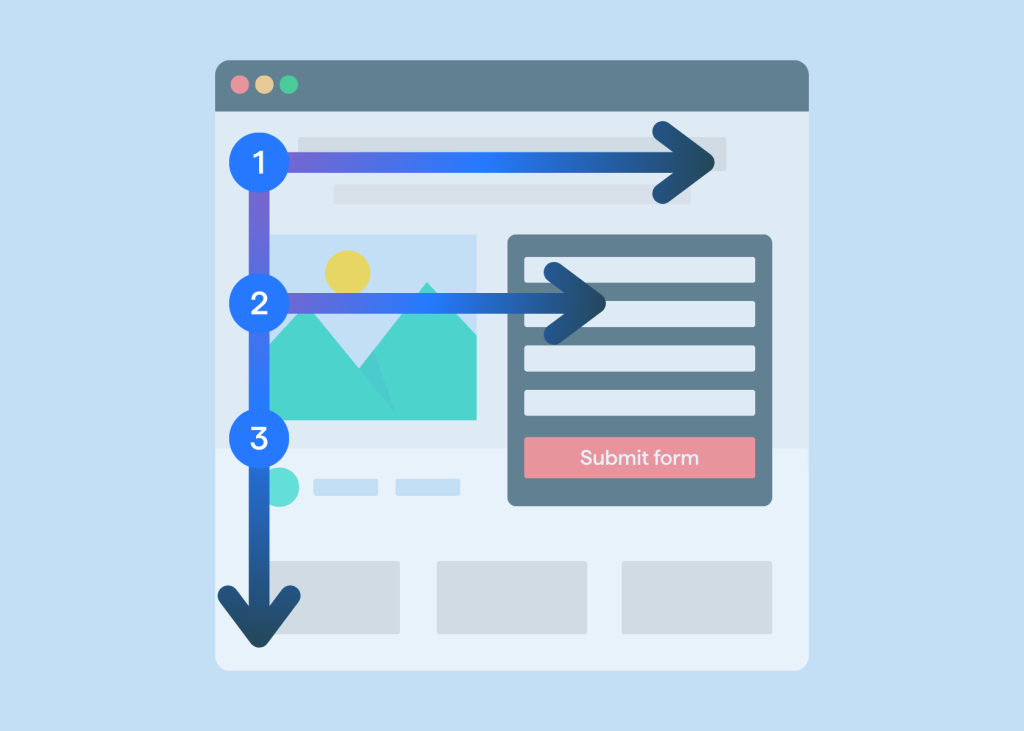
Lead with benefits, support with features. Always translate your product/service features into how they improve the user’s life or solve their problem. Compelling copy answers “What’s in it for me?” at every turn. It’s not enough to say “We have X feature”; you need to tie it to a benefit: “X feature saves you time by doing Y automatically.
Use simple, conversational language. Imagine you’re explaining your offer to a friend in one or two sentences, that’s the tone you want. Avoid corporate or technical terms (unless your target audience is highly technical and expects it). Keep the voice active and positive. Use “you” and “your.”. For example, instead of “The first month’s fee is waived for those who register”, say “Sign up today and your first month is free.”
Be specific and use numbers or proof when possible. Vague copy is the enemy of credibility. “Clear” often means quantifiable or tangible. If you have stats, proof points, and concrete claims, use them.
Test your headline (and key copy) on others. Sometimes, as creators, we are too close to our product. We use internal jargon and assume prior knowledge, and our target audience ends up confused. To avoid this, do a 5-second test: Show your headline or value proposition to someone not intimately familiar with your product. Can they say what you do and why it matters? If they struggle, your copy isn’t clear enough. Tweak wording for clarity above all. Clever puns might sound cool, but clarity converts.
Use emphasis sparingly. Bold a few high-impact phrases like “Free for 14 days” or “No credit card required.”. But don’t overdo it. If everything is highlighted, nothing stands out. Remember, you are trying to catch the eye of the scanners.
The goal of your landing page text is not to win a literary award; it’s to convert a skeptical, time-pressed visitor into a lead or customer.
Involve.me tip: Try asking the built-in AI agent for headline and bullet ideas. Additionally, involve.me supports dynamic text replacement and personalization. That means your copy can automatically include a visitor’s name, company, or any variable you pass in. A headline like “Welcome, Sarah. Here’s your custom plan.” can lift engagement. With involve.me, inserting these dynamic placeholders is easy, no coding, just select from personalization options.
Try the involve.me AI Agent, it's free!
8) Why is Page Speed So Critical?
Because slow loading pages lose clicks. Mobile visitors, especially, bail fast. A delay of a couple seconds can tank conversion rates. In fact, 53% of mobile users will abandon a site if it takes longer than 3 seconds to load. That’s more than half your potential conversions gone due to slow speed! Fast pages feel trustworthy, improve ad Quality Score, and are friendlier to SEO (search engine optimization).
Here is how to make your landing page load fast:
Compress and resize images. Use compressed formats (JPEG, PNG, or modern WebP) and scale images to the max dimensions needed (don’t load a 5000px wide image if it only displays at 500px). Several tools can compress images without visible quality loss. This can drastically cut load times.
Minimize scripts and third-party tags. Every extra script (analytics, widgets, etc.) can add loading time, especially if they’re render-blocking. Keep only what you truly need. Load non-critical code later.
Use quality hosting and a CDN. Good landing page builders like involve.me host content on optimized servers and CDNs, which distribute load globally. This reduces latency for users around the world. If you host on your own site, a CDN (Content Delivery Network) is highly recommended to speed up global access.
Defer heavy assets, lazy-load offscreen media. Make sure the assets in the above-the-fold section load instantly, but defer offscreen elements.
Leverage browser caching. If you have returning visitors or a multi-step funnel, caching can help. But for single landing pages (often first hit), caching is less of a direct factor for that first view. Still, it’s good practice to have headers that allow returning visitors to not re-download resources.
Test often. Use tools like Google PageSpeed Insights or GTmetrix. They’ll not only give you a score but also specific suggestions to improve landing page performance. While you may not hit a perfect 100 score (especially with third-party elements), you can often find a few quick wins.
Involve.me tip: Your funnels and landing pages are optimized and mobile-friendly out of the box, running on a global CDN with smart asset handling. Still, avoid giant background videos and oversized images.
9) How Do You Design for Mobile Devices?
Plan for phones first. Most of your website traffic is already there. “Designing for mobile” means crafting your page so that it looks good, loads fast, and is easy to use on a small touchscreen.
Here’s how to make sure your mobile users love your well-designed landing page:
Responsive, single-column layout. Your landing page layout should automatically adapt to smaller screens. This means stacking elements vertically, resizing images, and avoiding horizontal scrolling or squished content.
Prioritize key info “above the scroll”. Similar to above the fold on desktop, but on a mobile landing page, it’s a smaller viewport. Make sure your headline and CTA are visible immediately on a phone screen. If you have a form with many fields, maybe show the first fields or a big “Start” button that jumps to the form.
Make buttons and links thumb-friendly. On a touchscreen, small links or tightly spaced buttons are a nightmare. Make tappable elements big, full-width, with breathing room. If you have checkboxes or radio buttons in a form, make the labels clickable too so that the user can tap the text. Nothing is worse than trying to tap a tiny checkbox with your pinky.
Simplify forms. Use multi-step form design to break it into two smaller steps. Use mobile-friendly input types (Eg. email inputs use the email keyboard, numeric inputs for phone numbers trigger the number pad). These small touches make form completion much smoother on a phone.
Ensure text is legible without zoom. Use a reasonably large font size for body text (around 16px), and adapt heading size as well. They can be larger, but shouldn’t occupy too much vertical space (reduce line height). Make sure your text contrasts well with the background (Glare can make low-contrast text invisible outdoors)
Optimize images and media for mobile. Mobile devices may have slower connections and data limitations. Use optimized images (as discussed in page speed) and consider a static image on mobile devices instead of video backgrounds, as they can be really heavy. Additionally, ensure the images you use still look good on a smaller screen (tiny details or text might not be visible on mobile landing pages).
Test on real devices. Don’t rely only on a desktop browser’s responsive view. Open your landing page on actual phones (iOS and Android), with different screen sizes, and check both portrait and landscape orientations.
Involve.me tip: involve.me is mobile-optimized and responsive by default. Every template and element in involve.me’s library is built to rearrange nicely on smaller screens. The drag and drop landing page builder also includes a preview for mobile view, so you can see how your page will look on a phone and make adjustments if needed (still, test is on a real device as well).
10) Why and How Should You A/B Test Your Landing Pages?
Because guessing which version of your landing page works best is just that, guessing. A/B testing gives you answers so you can make data-driven decisions.
A/B testing is critical for continuous improvement. Rather than launching one landing page and hoping for the best, you experiment: different headlines, images, layouts, etc., and let user behavior tell you what works. This is especially important in a world where small tweaks can mean big differences, like a 10% bump in conversion could mean a lot more revenue for you.
Some key points on why A/B testing is worth it:
Eliminates HiPPO syndrome (Highest Paid Person’s Opinion). Cuts debates short. Test ideas, pick the winner based on results.
Compounds gains. Ten percent here, eight percent there, and suddenly you have a star.
Teaches target audience preferences. You discover insights about your target audience and can leverage these for other areas of your marketing activities (search ads, emails, product, search engine optimization).
Lowers risk. A/B testing allows you to validate changes on a portion of traffic first, before rolling out a big change.
Now, how to A/B test:
Test one variable at a time. This means creating two versions of the page that are identical except for one element (headline, CTA text or color, hero image, form length, page length, proof placement…). By isolating one element, you can be confident that any conversion difference is due to that change.
Split traffic randomly between A and B. Most A/B testing tools handle this for you. Essentially, half of your visitors see Variant A, the others see Variant B, without knowing it. Ensure the split is random and equal (and that you have enough traffic for the split to be significant, more on that below).
Track a single, clear desired action / goal. On a landing page, it’s typically form submissions, purchases, or CTA clicks for click-through landing pages. Don't forget to set this goal as Key Event on Google Analytics for easy tracking.
Run the test for a sufficient sample size and time. Don’t jump to conclusions after 10 conversions. You want to be sure the result isn’t due to random chance. Aim for at least a couple hundred conversions per variant if possible, and run over multiple days (to take daily variation into consideration). If you have low traffic, run the test for a few weeks. Patience is key to get trustworthy data.
Ship the winner, learn, and test again. If one version clearly outperforms, then roll it out as your new default. Learn from it - why might it have won? – and use that insight for future ideas. If results are inconclusive, that’s also a learning (maybe the change didn’t matter). Then you formulate a new hypothesis and test something else. A/B testing is an ongoing cycle.
Involve.me tip: involve.me has built-in A/B testing that make this process super easy. You can duplicate a page variant with one click, make your change in the builder, and then send a percentage of visitors to each version. Involve.me will then track several metrics for each variant and show you the data. Essentially, you don’t need a third-party testing software, it’s integrated. Keep in mind that if you want more control, or to compare more than 2 versions at the same time, you will need a dedicated A/B testing tool.

11) Should You Use Templates or Go Custom?
For most teams, templates win. You ship faster, start from proven layouts, and still make it yours.
Why templates help:
Speed. Launch in hours, not weeks. This means you can start generating leads or sales sooner.
Conversion-first structure. Good templates are designed based on what’s been shown to work. Headline, social proof, CTAs, forms, and mobile behavior are baked in.
Brandable. Templates usually allow a high degree of customization. Swap colors, fonts, imagery, and sections.
Lower risk. A template is typically tested for usability. Templates reduce the risk of design mistakes because they follow conventional patterns that users find familiar.
Always improving. Template libraries often get updated with new landing page designs reflecting the latest trends or data.
So in general, for most use cases, a template > a blank page. The only time custom landing page design might be needed is if you have very specific, unique requirements that a template can’t match, or you have a strong brand guideline that requires a totally bespoke layout. Even then, you might use a template as a starting point and heavily modify it.
Involve.me tip: Browse hundreds of templates for forms, quizzes, landing pages and more. Drop in your content, and save your customized version as your team’s “master” to clone for future campaigns. Responsive, fast, and test-ready from day one.
Whitepaper Download Template
Appointment Funnel Template
Lead Magnet Quiz for Real Estate Template
Agency Lead Generation Form Template
Customer Profiling Survey for Ecommerce Template
Website ROI Calculator Template
BONUS: Lead Gen Landing Page Best Practices
Lead generation pages designed to capture a visitor’s contact info or other data have a few extra tricks that can significantly increase conversion rates and lead quality. Try these for your lead form:
Use multi-step forms. Break the process into multiple smaller steps. Multi-step forms are psychologically easier. Completing a few short steps feels less daunting than one long wall of fields. Little tip: add a progress bar so people feel the momentum.
Reduce typing with smart inputs. The harder a form is to fill, the fewer leads you’ll get, especially on mobile. Wherever possible, use form fields that minimize typing: dropdowns, radios, sliders, date pickers. Fewer keystrokes, fewer errors, higher completion.
Reassure on privacy. In lead gen, you’re asking for personal data, so you must address trust and legal concerns. Add a short note near the button and link your privacy policy. If you need consent, make it clear and simple. Trust wins submissions.
Make the thank-you page work. After a user submits the form, don’t just give a generic success message. Celebrate the win, set expectations, and offer a next step. For example: Join the webinar, grab a promo code, follow on LinkedIn, book a call… In short, keep the conversation going.
Involve.me tip: Build landing pages and multi-page flows with logic jumps, add progress bars, and use interactive inputs out of the box. Drop in a GDPR consent checkbox and a privacy blurb. Then design a custom thank-you screen with a secondary offer, calendar embed, or personalized message based on answers.
To Wrap Up
High-converting landing pages aren’t born. They’re built, tested, and improved. Start with the landing page best practices that move fast: compelling headlines, tight message match, mobile-first design, and rapid A/B tests. Every landing page element must earn its keep. It either persuades or captures the lead. If not, it’s noise.
Treat this as a journey. Ship the fundamentals, then refine. Use data. Watch behavior. Iterate. The page you launch this month can be better next month.
You also don’t have to do it alone. involve.me gives you a builder and templates that encode landing page best practices. Spin up pages quickly, integrate forms, add visuals, and match your brand in an afternoon. Built-in analytics and testing help you see what works and optimize your landing page fast.
Your simple recipe:
Clear value proposition in seconds
Visual persuasion that guides the eye
Trust elements at key doubts
Fast, focused layout with one obvious next step
Ongoing testing and tuning
Ready to apply it? Use involve.me’s drag-and-drop builder and conversion-ready templates to put these landing page best practices to work and turn more traffic into customers.
Build a high-converting landing page
Your Landing Page Questions, Answered
-
Not always. But they can. Some studies showed videos might bump up conversions by as much as 80%. That’s a big deal. But it all comes down to how you use them. A short, punchy product demo or a solid customer testimonial? That can grab attention fast and explain your value clearly. But a long, dull, or off-topic video? That’s a conversion killer. It slows the page and gets ignored. So here’s the smart move: test it with and without the video, keep it under 60 seconds, and make sure it doesn’t tank your page speed.
-
Yep. One size doesn’t fit all. For paid traffic, like Google or Facebook ads, your page needs to match the ad. That means using a headline that echoes the ad copy and keeping a tight focus on the offer you promised. This helps with conversions and can boost your Google Ads Quality Score.
For organic traffic (like SEO), the intent might be broader. You may want more in-depth content and some internal links, especially for SEO-heavy pillar pages. That said, if the organic goal is still conversion-focused, keep it streamlined. Just make sure it’s optimized for the keywords bringing people in.
A lot of brands build two versions: one for PPC that's clean and minimal with no nav, and one for SEO that's content-rich and a bit more detailed.
-
As long as it needs to be. No longer. If your offer is simple, like a free checklist, a short page might do the trick. Just a headline, some quick benefits, and a form. But if you’re selling something pricey or complex? You’ll need more copy to explain, convince, and reduce objections.
Here’s how to find the right length: start with a moderate page. Watch your scroll and click data. If people bail early, trim the fluff. If they scroll but don’t convert, add clarity or proof.
And on long pages, repeat your CTA after every key section. Don’t make people scroll forever to take action.
-
Use UTM parameters and analytics tracking. Add UTM tags to each ad’s URL. For example, you might use something like ?utm_source=google&utm_campaign=SummerSale&utm_ad=TextAd1. Then plug into Google Analytics or use your ad platform’s pixel (Google, Facebook, etc.) to track what happens after the click.
If you’re using involve.me, it supports Google Analytics, Facebook Pixel, and its own native stats for views and conversions. You can even send UTM data to your CRM using webhooks, so you track lead quality later.
Want a simple setup? Stick to one landing page and tag traffic with UTMs. Want granular insights? Try multiple landing pages per ad, though it’s more work.
The goal is to see exactly which ads drive conversions, and double down on what’s working.
-
Absolutely. Tools like involve.me are built for non-coders. Everything’s visual. You drag, drop, click, and configure. No HTML, CSS, or JavaScript needed. Want to add a video? Create multi-step forms? A/B test headlines? Send leads to your CRM? All doable. No dev team required.
Even advanced stuff like interactive quizzes, complex calculators, and conditional logic is built right into the platform.
Bottom line: If you can move a mouse and type, you can build a pro-level landing page. Faster, cheaper, and without the coding headache.
-
Yes. It’s not just a landing page builder, it’s a full-on interactive funnel platform.
For events, you can build RSVP pages, collect attendee info, and even take payments through Stripe or other gateways. For ecommerce, you can create mini product pages, let users choose variants or quantities, and process orders and payments directly.
For lead gen, you can build gated content pages, run multi-step quizzes or forms, and integrate everything with tools like Mailchimp, HubSpot, or Salesforce.
For surveys and quizzes, you can make those fun Buzzfeed-style quizzes or branded assessments, complete with instant results.
Even giveaways and contests are possible. You can build entry forms and encourage users to share for extra entries, with a little help from tools like Zapier.
Whether you're selling, surveying, collecting leads, or onboarding users, involve.me’s no-code toolkit covers it all.
It’s used by SaaS companies, ecommerce brands, agencies, educators, and more. And because it’s all-in-one, your data stays consistent and your user experience stays smooth.

